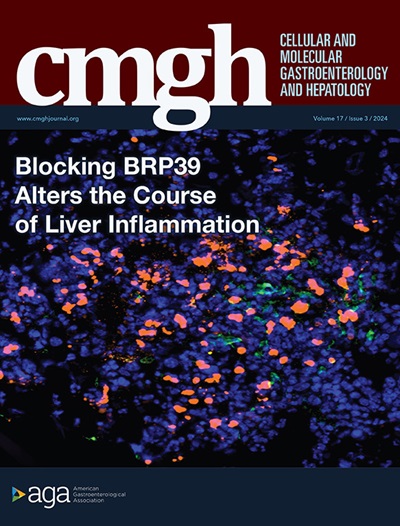Periplakin Attenuates Liver Fibrosis via Reprogramming CD44Low Cells into CD44High Liver Progenitor Cells
IF 7.1
1区 医学
Q1 GASTROENTEROLOGY & HEPATOLOGY
Cellular and Molecular Gastroenterology and Hepatology
Pub Date : 2025-01-01
DOI:10.1016/j.jcmgh.2025.101498
引用次数: 0
Abstract
Background & Aims
Liver progenitor cells (LPCs) contribute significantly to the restoration of injured liver parenchyma and promote liver regeneration, thereby ameliorating liver fibrosis. However, the mechanism of the derivation of LPCs remains poorly understood.
Methods
We first examined the expression of periplakin (PPL) in patients and mouse models with liver fibrosis. Adenovirus overexpressing PPL was injected into the tail vein of mouse models to detect the regulatory effect of PPL on liver fibrosis. Single-cell sequencing explored how PPL influences liver fibrosis progression. Additionally, PPL+CD44Low cells and PPL+CD44High LPCs were transplanted into 3,5-diethoxycarbonyl-1,4-dihydrocollidine–induced mouse models to assess their therapeutic efficacy in treating liver fibrosis.
Results
The expression of PPL is upregulated in fibrotic livers in human and mouse models of liver fibrosis. Functionally, we found that PPL overexpression significantly attenuated liver fibrosis. Mechanistically, PPL was specifically expressed in LPCs and promoted LPC expansion. Moreover, we observed that PPL+ cells could be categorized into PPL+CD44Low and PPL+CD44High subsets, and PPL+CD44Low cells were found to redifferentiate into PPL+CD44High LPCs during liver fibrosis. Furthermore, transplantation of PPL+CD44High LPCs notably suppressed liver fibrosis.
Conclusions
These findings demonstrate that PPL+CD44Low cells can be reprogrammed into PPL+CD44High LPCs, which ameliorate liver fibrosis, suggesting a potential application of PPL for the treatment of liver fibrosis.

Periplakin通过将CD44Low细胞重编程为CD44High肝祖细胞来减轻肝纤维化。
背景与目的:肝祖细胞(Liver progenitor cells, LPCs)对损伤肝实质的修复和肝脏再生有重要作用,从而改善肝纤维化。然而,LPCs的衍生机制仍然知之甚少。方法:我们首先检测PPL在肝纤维化患者和小鼠模型中的表达。将过表达PPL的腺病毒注入小鼠模型尾静脉,检测PPL对肝纤维化的调节作用。单细胞测序探索PPL如何影响肝纤维化进展。此外,将PPL+CD44Low细胞和PPL+CD44High LPCs移植到ddc诱导的小鼠模型中,评估其治疗肝纤维化的疗效。结果:PPL在人和小鼠肝纤维化模型中表达上调。功能上,我们发现PPL过表达显著减轻肝纤维化。机制上,PPL在LPC中特异性表达,促进LPC扩增。此外,我们观察到PPL+细胞可分为PPL+CD44Low和PPL+CD44High亚群,PPL+CD44Low细胞在肝纤维化过程中可再分化为PPL+CD44High LPCs。此外,PPL+CD44High LPCs移植可显著抑制肝纤维化。结论:这些发现表明PPL+CD44Low细胞可以被重编程为PPL+CD44High细胞,从而改善肝纤维化,提示PPL在肝纤维化治疗中的潜在应用。
本文章由计算机程序翻译,如有差异,请以英文原文为准。
求助全文
约1分钟内获得全文
求助全文
来源期刊

Cellular and Molecular Gastroenterology and Hepatology
Medicine-Gastroenterology
CiteScore
13.00
自引率
2.80%
发文量
246
审稿时长
42 days
期刊介绍:
"Cell and Molecular Gastroenterology and Hepatology (CMGH)" is a journal dedicated to advancing the understanding of digestive biology through impactful research that spans the spectrum of normal gastrointestinal, hepatic, and pancreatic functions, as well as their pathologies. The journal's mission is to publish high-quality, hypothesis-driven studies that offer mechanistic novelty and are methodologically robust, covering a wide range of themes in gastroenterology, hepatology, and pancreatology.
CMGH reports on the latest scientific advances in cell biology, immunology, physiology, microbiology, genetics, and neurobiology related to gastrointestinal, hepatobiliary, and pancreatic health and disease. The research published in CMGH is designed to address significant questions in the field, utilizing a variety of experimental approaches, including in vitro models, patient-derived tissues or cells, and animal models. This multifaceted approach enables the journal to contribute to both fundamental discoveries and their translation into clinical applications, ultimately aiming to improve patient care and treatment outcomes in digestive health.
 求助内容:
求助内容: 应助结果提醒方式:
应助结果提醒方式:


